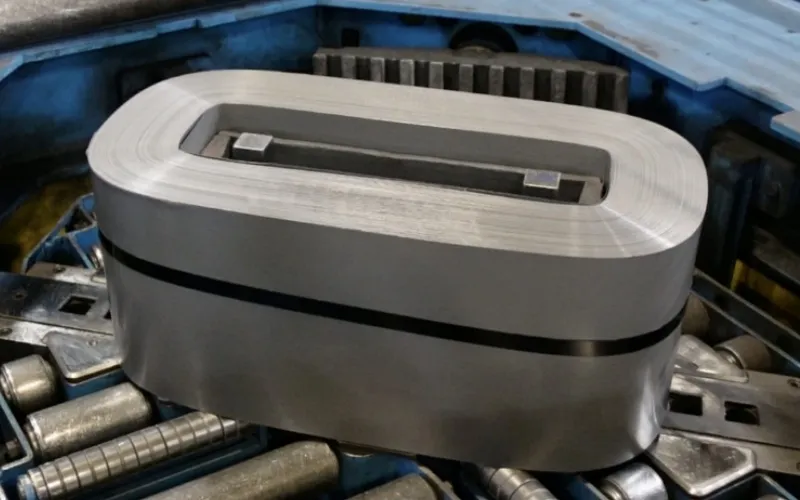1. Composition
What is Stainless Steel?
Stainless steel is an alloy primarily made of iron, carbon, and a minimum of 10.5% chromium. The addition of chromium is what gives stainless steel its corrosion-resistant properties. Depending on the grade, other elements such as nickel, molybdenum, and manganese may also be added to enhance specific characteristics, such as strength, ductility, and resistance to oxidation.
What is Silicon Steel?
Silicon steel, also known as electrical steel, is primarily made of iron with a significant addition of silicon, typically ranging from 1% to 6.5%. The silicon content greatly improves the magnetic properties of the steel, making it suitable for electrical applications.
![]()
2. Grades
Stainless steel is more commonly seen in our daily lives in many different forms. They include:
Austenitic Stainless Steel (Common examples include 304, 316, and 321)
Martensitic Stainless Steel (Common examples include 410, 420, and 440C)
Ferritic Stainless Steel (Common examples include 430 and 443)
Duplex Stainless Steel (Common examples include 2205 and 2207)
Precipitation-hardening Stainless Steel (Common examples include 17-4PH(05Cr17Ni4Cu4Nb) and 630(Aviation Grade)).
On the contrary, silicon steel is usually categorized into two main forms according to the microstructure: grain-oriented (GO) and non-grain-oriented (NGO).
Grain-oriented silicon steel (GO): specifically designed to maximize the magnetic properties of the alloy along a single direction. The grain structure is aligned during the manufacturing process, which improves the material’s ability to conduct magnetic flux in a uniform direction.
Non-Grain-Oriented Silicon Steel (NGO): differs from GO silicon steel in that its crystalline grains are oriented randomly, making NGO silicon steel more suited for applications where the magnetic field is not aligned in a single direction.
3. Thickness
It’s obvious that silicon steel is much thinner than stainless steel in terms of thickness.
Silicon steel is often produced in thin sheets/laminations to minimize energy losses due to eddy currents in electrical applications, particularly in transformer cores and electric motors. Generally, the thickness does not exceed 1.0mm, with 0.23, 0.27, 0.35, 0.5 more common.
Stainless steel has a wide scope of thickness, ranging from 0.02mm to 100mm. For example, the ultra-thin stainless steel foil can be as thin as 0.02mm; and stainless steel medium-thick plate can achieve up to 50mm approximately. This wide selectivity makes stainless steel more popular in many different applications.

4. Properties
They also have many differences in terms of corrosion resistance, magnetic properties, and mechanical strength.
Corrosion Resistance
Stainless steel is much more resistant than silicon steel. This is due to the high chromium content in stainless steel that forms a passive layer of chromium oxide on the surface, protecting the underlying metal from rust and other forms of corrosion. This makes stainless steel ideal for applications in harsh environments, such as chemical processing plants and marine environments.
Magnetic Properties
Silicon steel is specifically designed for its magnetic properties — the presence of high silicon content, making it ideal for applications involving electromagnetic fields. It has high magnetic permeability, which allows it to conduct magnetic lines of force efficiently, and low eddy current losses, contributing to the efficiency of transformers and electric motors. In contrast, stainless steel is generally not magnetic due to its alloying elements, particularly in austenitic grades, which have a face-centered cubic structure.
Mechanical Strength
Stainless steel is also known for its strength and durability. It can withstand high levels of stress and is resistant to deformation and wear. This property makes it suitable for structural applications, such as construction, automotive, and aerospace.
Silicon steel, while it possesses adequate mechanical strength for its applications, is not designed for high-stress environments and is more suited for intended purpose in electrical applications.
5. Applications
Due to its superior corrosion resistance, stainless steel is widely used in various industries, including:
Construction (bridges, buildings, and facades)
Food and beverage
Medical instruments and surgical tools
Chemical processing
Kitchen appliances, cutlery, and cookware
Automotive and aerospace components
Conversely, silicon steel finds its primary applications in electrical and electronic fields. It is extensively used in manufacturing the core of transformers, electric motors, generators, inductors, and other electromagnetic equipment. The efficiency improvements offered by silicon steel are critical in industries that rely on energy conservation and performance.
*Can stainless steel replace silicon steel in electrical applications?
No! Though some variant of stainless steel has magnetic properties, they are far inferior to those of silicon steel. Using it in electromagnetic equipment will result in extremely low efficiency and severe heat generation.

6. Cost and Manufacturing
Stainless Steel tends to be more expensive to fabricate due to alloying elements like chromium and nickel. Besides, it requires precise manufacturing to maintain corrosion resistance, which adds an additional fee to the overall manufacturing cost.
Silicon Steel maintains a lower cost but requires specialized processing (e.g., annealing) to optimize magnetic properties. But overall, it costs less than stainless steel.
Summary of Key Differences Between Stainless and Silicon Steel
The following table better highlights the differences between them. Take a look now:
| Items/Characteristics | Stainless Steel | Silicon Steel |
| Composition | Iron, carbon, and chromium | Iron with 1-6.5% silicon |
| Thickness | 0.02mm — 100mm | <1mm |
| Corrosion Resistance | Excellent | Poor |
| Magnetic Properties | Generally non-magnetic | High magnetic performance |
| Mechanical Strength | High strength and durability | Adequate strength; not for high-stress |
| Primary Applications | Construction, aerospace, medical, food processing | Electrical devices like transformers, electric motors, generators |
| Cost | Higher | Lower |
Conclusion
In summary, while both stainless steel and silicon steel are essential materials in modern manufacturing, they serve vastly different purposes. Stainless steel is favored for its corrosion resistance and mechanical strength, making it suitable for a wide range of applications in harsh environments. Silicon steel, on the other hand, is specifically designed for electrical applications, offering superior magnetic properties essential for the efficient operation of electrical devices. Understanding the differences between these two materials is essential for selecting the right one for specific applications, ensuring optimal performance and longevity.

